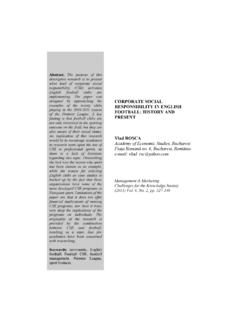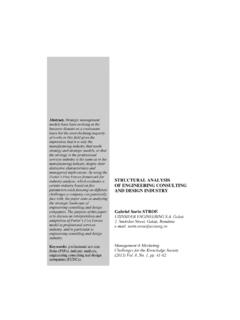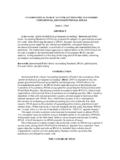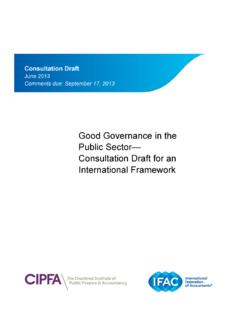Transcription of A COMPREHENSIVE STUDY AND ANALYSIS OF …
1 Abstract. The power sector is one of the most critical growth drivers for any country. The power sector in India is highly regulated by the government and is dependent on the policies framed regarding bidding for power projects, regulations regarding transmission of power between states and pricing of power supply to consumer is also decided by the government. In India, the passage of the Electricity Act, 2003 brought about an impetus in the sector which paved way for new reforms in it. India certainly needs a huge jump in its electricity supply to sustain its rapid economic growth and meet the growing demand; it needs to make every effort to efficiently manage all components of value chain. In order to provide adequate support to country s growth aspirations, it is imperative that the sector scales its capacity up across the value chain and push reforms in requisite stages.
2 This paper firstly presents the overview of Indian power sector followed by ANALYSIS of value chain of power sector in India -its current scenario as well as future prospects. Keywords: power sector , value chain, power generation, transmission and distribution, power trading, smart grid. A COMPREHENSIVE STUDY AND ANALYSIS OF POWER sector VALUE CHAIN IN INDIA Sita MISHRA Institute of Management Technology Rajnagar, Hapur Road, Ghaziabad, India e-mail: Management & Marketing Challenges for the Knowledge Society (2013) Vol. 8, No. 1, pp. 25-40 Management & Marketing 261. Introduction Almost a decade ago, India's government under the National Electricity Policy set an ambitious target of electric power for all by 2012.
3 It seems to miss its target by almost 60%. Though, India is the world's fifth-largest electricity producer after the , China, Japan and Russia, but its per capita consumption is among the world's lowest, at kilowatt hours a year as reported by the Wall Street Journal (Eric, 2012). Almost 300 million people don't have access to electricity. The power sector in India has evolved rapidly after the reforms introduced through the 2003 Electricity Act. It has grown tremendously in the last decade from an installed base of 100,000 MW in 2001 to 207,006 MW by August 2012 as per Central Electricity Authority (CEA). The 2003 Electricity Act introduced much needed reforms in the power sector such as unbundling of State Electricity Board s into separate generation, transmission and distribution entities, and removal of license for setting up generation unit by any individual or corporation along with other reforms in distribution and transmission sector respectively.
4 National and international statistics usually demonstrate energy use in the end use sectors in final energy terms. Final energy consumption signifies the direct amount of energy consumed by end users whereas primary energy consumption includes final consumption plus the energy that was needed to produce and deliver electricity. In India, the factor that converts final electricity consumption to primary energy is relatively high and was equal to in 2005 (de la Rue du Can and Price, 2008). Consequently, consuming one unit of energy from electricity is equal to consuming more than four units of energy at the source of generation. This large primary energy conversion factor can be explained by two reasons; firstly electricity distribution and transmission (T&D) technical and commercial losses are substantial and secondly electricity is generated for a large part with the use of fuel combustion with low efficiency.
5 India s transmission and distribution (T&D) network losses is approximately 25% (Ebinger and Avasarala, 2012) as compared to the world average of less than 15%. While by arresting the heavy T&D losses, almost 30GW of electrical power can be saved, the forthcoming need for India is definitely an efficient value chain of power sector . The power sector is endeavoring to meet the challenge of providing adequate power needed to fuel the growing economy of the country. As the Indian economy continues to surge ahead, its power sector has been expanding concurrently to support the growth rate. The demand for power is growing exponentially and the scope for the growth of this sector is immense.
6 The centre has targeted capacity addition of 100,000 megawatt (MW) each in the 12th Five Year Plan (2012-17) and 13th Five Year Plan (2017-22). However, this growth of the power sector has to be within the realms of the principles of sustainable development. While India certainly needs a huge jump in its electricity supply to sustain its rapid economic growth and meet the growing demand, it needs to make every effort to efficiently manage all stages of value chain. Therefore, A COMPREHENSIVE STUDY and ANALYSIS of power sector value chain in India 27focus should be on maximizing efficiency in the entire electricity chain, which has the duel advantage of conserving scarce resources and minimizing the effect on the environment.
7 2. Overview of India s power sector India s energy-mix comprises both non-renewable (coal, lignite, petroleum and natural gas) and renewable energy sources (wind, solar, small hydro, biomass, cogeneration bagasse etc.). Nuclear fuel is also being used for power generation by government utilities and is limited only to government sector . The Indian power sector is largely coal based with the total installed capacity comprising of 99,503 MW (55%) coal based, 17,706 MW (10%) gas based, 1200 MW (1%) diesel generation, 38,206 MW (21%) hydro, 4,780 MW (2%) nuclear and 20,162 MW (11%) from renewable energy sources. The country is looking beyond fossil fuels; at nuclear energy and renewable energy in a big way.
8 Renewable energy will play a key role for the sector indeed. However much needs to be done to realize the true potential of renewable energy sources. As per industry estimates, India s solar power generation potential is close to 5,000 TWh per annum, however the initial cost of set-up acts as a major detriment and therefore the generation and utilization of solar power is far below its potential. The same stands true for wind energy as well (Grant Thornton report, 2012). Energy is available through various types of products; it is often transformed to more refined products, and it is finally consumed to operate a multitude of activities. Energy is a necessary input to any type of activity in the economy.
9 Electricity production requires on average three times its final energy content (de la Rue du Can and Price, 2008). Final energy consumption represents the direct amount of energy consumed by end users while primary energy consumption includes final consumption plus the energy that was necessary to produce and deliver electricity. The demand for electricity in the country has been growing at a rapid rate and is expected to grow further in the years to come. In order to meet the increasing requirement of electricity, massive addition to the installed generating capacity in the country is required. According to CMIE approximations, coal-based power generation would increase by around 19200 mw.
10 Since thermal power accounts for 80-85% of the power generated in the country, it is the biggest factor in any increase in power generation. Nuclear power generation is likely to grow by in the current financial year due to improved availability of uranium and rise in installed capacity. Thermal power generation increased on the back of a healthy growth in power generation capacity. Nuclear power generation also grew to billion units. India has the third largest coal reserves and fourth in terms of production in world. As per planning commission estimates India would still have 50% plus power generation on coal by 2030. 77% of non-coking coal in India was consumed only by the power sector , for generation of electricity in the country and the remaining is used in other industries such as steel, cement, fertilizers, bricks manufacturing, textiles and Management & Marketing 28chemicals.











